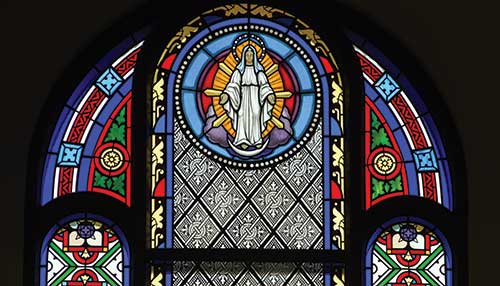Shining a light
Course ideas spring from various sources — some formal, some chance. You may have read in this space in the last issue of UD Magazine of the efforts, such as retreats, to acquaint new faculty with the University’s mission and to further their interest in it.

R. Darden Bradshaw and Sandra Yocum met at a new faculty retreat and developed an idea that was inspired by staff in Facilities Management asking Bradshaw, who teaches art education in the department of art and design, a question: Can you do anything with these windows? The windows were the 20th-century ones in the nave of UD’s Chapel of the Immaculate Conception.
“We were both interested in materials embodying experience,” said Yocum, who teaches religious studies. Yocum and Bradshaw, with art and design colleague Geno Luketic, developed a course taking the glass as the basis for a material visual culture investigation into what it means to be a UD student or faculty and staff member.
“We looked at how the material could be representative of the Marianist charism,” Bradshaw said.
Later Yocum and Bradshaw moved their thinking beyond the scope of the Marianist tradition. The result is a course called The Light That Sustains Us: Exploring Art & Faith, which looks at four great traditions — Buddhism, Christianity, Islam and Judaism — in which art and faith connect, inform and sustain each other. “It’s a sustainability,” Yocum said, “that goes beyond the physical to the spiritual and the philosophical.”
Yocum gives students an overview of the faith tenets of each tradition. Then Bradshaw explores art and physical elements and their ties to faith. “I start with historical architecture and then move to more contemporary expressions,” Bradshaw said.
“Besides incrementally gaining a richer understanding of each faith tradition every time I teach this course,” Yocum said, “I have learned so much about art making and the power of creating visual representations as a powerful expression of belief.”
"I have learned so much about art making and the power of creating visual representations as a powerful expression of belief."
Each student creates visual journal entries reflecting on the relationship of art and faith. And, working collaboratively with at least one other student, each designs and creates an artifact that has a theologically informed identity. Student creativity is spurred by guest artists from various faith traditions. Each student is required to compare two of the four faith
traditions.
Viewing faith tradition through their art yields some striking comparisons. Jewish and Islamic art relies heavily on text and design. The figure of Buddha yields intricate and diverse representations. And Christianity presents a plethora of portrayals of Christ and saints. Images of Mary may be so numerous, Yocum offered, because of her crucial role in the Incarnation.
The course matches two required areas of UD’s Common Academic Program — Faith Traditions and Crossing Boundaries — as it crosses boundaries not only of academic disciplines but also of theological beliefs.
Yocum has been impressed by “how creative our students can be even when they find themselves out of their comfort zone.”
By pushing themselves beyond their past experiences, they develop, Bradshaw said, “a tangible, hands-on visual, as well as a linguistic, vocabulary.”